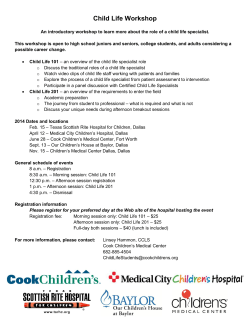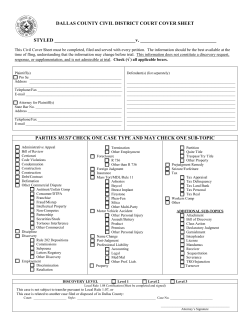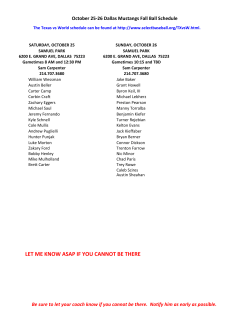
Dallas - Baylor Health Care System Online Newsroom
Baylor Scott & White BaylorHealth.com/Dallas B a p aylo art r H e of Ba alth ylo Ca r S re cot Sys t & tem Wh is ite now He alt h JANUARY 2015 ‘‘I wanted to live my life to the fullest— and now I can. ‘‘ Janice Collins didn’t let an overactive bladder slow her down PAGE 6 The greatest gift What you need to know about living donor kidney transplants page 4 FdBL011501_BUMC 2.indd 1 12/17/14 12:28 PM QUICK HITS Making the GRADE The Baylor Endocrine Center is working with the National Institutes of Health to make life better for people with diabetes. Free Women’s Wellness Event Start the new year off right with For Women For Life! ™ Th is free women’s health and wellness event gives you the tools to keep you and your family healthy. Enjoy a light breakfast, get answers to your questions at our physician panels and browse our health and wellness booths for the latest in preventive health and treatment options. Free screenings include blood pressure, body composition, and if you fast for eight hours, you can even have your cholesterol checked on-site. Additional activities include a yoga class and a cooking demo. Plus, a wide variety of health experts will be on hand. Be sure to preregister so you can participate! Bring your mother, your sister, your daughter or your friend. Learn how the choices you make today can improve your quality of life for years to come. You take care of everyone else—let us take care of you! For Women For Life™ Jan. 24, 9 a.m. to noon Baylor Charles A. Sammons Cancer Center 3410 Worth St. Dallas, TX 75246 The two organizations are collaborating on the GRADE Study—Glycemic Reduction Approaches in Diabetes: A Comparative Effectiveness Study. It is the first clinical research study designed to find out which of four FDA-approved diabetes medications, when combined with metformin (Glucophage®), is most effective in treating type 2 diabetes. You may qualify to participate in the study if: You are taking metformin only to manage your diabetes. Your condition was diagnosed in the past 10 years. “We want to help people achieve the best blood sugar control possible,” says Priscilla Hollander, MD, PhD, medical director for diabetes for Baylor Health Care System and principal investigator for the GRADE Study. M O RE SAVE YOUR SPOT! Go to BaylorHealth.com/ DallasFWFL or call 1.800.4BAYLOR to register. Join Our Diabetes Study To learn more about the GRADE Study, call us at 214.820.8848. Baylor University Medical Center at Dallas, 3500 Gaston Ave., Dallas, TX 75246. Patient Information: 214.820.0111. Volunteer Opportunities: 214.820.2441. Giving Opportunities/Baylor Health Care System Foundation: 214.820.3136. Visit BaylorHealth.com or call 1.800.4BAYLOR for information about Baylor University Medical Center at Dallas services, upcoming events, physician referrals, career opportunities and more. Baylor Health Care System Mission: Founded as a Christian ministry of healing, Baylor Health Care System exists to serve all people through exemplary health care, education, research and community service. CEO, Baylor Health Care System: Joel Allison. President, Baylor Health Care System: Gary Brock. President, Baylor University Medical Center at Dallas: John B. McWhorter III. Marketing/Public Relations Director: Jana Pope. Editor: Breck Yakulis. Baylor University Medical Center at Dallas Board of Directors: Timothy Owens, Chair; Dighton Packard, MD, Vice Chair; CT (Sparkey) Beckham; Judge Oswin Chrisman; Shelly Conroy; Gary Cook; Michael L. Graham; James H. Gray, MD; Charles Ku; Robert Mennel, MD; Ronald D. Murff; J. Kent Newsom; Michael Ramsay, MD; Gretchen Williams; Donald H. Wills; John B. McWhorter III. The material in Baylor Scott & White Health is not intended for diagnosing or prescribing. Consult your physician before undertaking any form of medical treatment or adopting any exercise program or dietary guidelines. Physicians are members of the medical staff at one of Baylor Health Care System’s subsidiary, community or affiliated medical centers and are neither employees nor agents of those medical centers, Baylor University Medical Center at Dallas or Baylor Health Care System. Photographs may include models or actors and may not represent actual patients. Baylor Scott & White Health is published by McMURRY/TMG, LLC six times a year for friends and supporters of Baylor University Medical Center at Dallas. © 2015 Baylor Health Care System. If you are receiving multiple copies, need to change your mailing address or do not wish to receive this publication, please send your mailing label(s) and the updated information to Robin Vogel, Baylor Health Care System, 2001 Bryan St., Suite 750, Dallas, TX 75201, or email the information to robinv@BaylorHealth.edu. 2 BaylorHealth.com/Dallas FdBL011501_BUMC 2.indd 2 ©Thinkstock 12/17/14 12:28 PM T If tw 1 an ma on sub ©Th 1.3 million The Latest Fitness Crazes The number of annual vehicle crashes that happen because of weather—from rain to snow to ice. As a result, 6,250 people are killed. Ready to get in shape this year? See which of the trendiest workouts might be right for you. This winter, take it slow on the roads and always wear your seat belt. TREND: CROSSFIT TREND: BARRE TREND: HOT YOGA WHAT IS IT? This intense WHAT IS IT? Ballet WHAT IS IT? These yoga program uses explosive and plyometric (jump training) exercises. WHO’S IT BEST FOR? Experienced exercise enthusiasts. CAUTION: The intensity of the exercises increases risk of injury. barre-based workouts sculpt lean muscle mass and improve balance, core stability and range of motion. WHO’S IT BEST FOR? All fitness levels. CAUTION: Classes can be expensive. A BETTER YOU Make this year your year! Visit BaylorHealth.com/ LiveBetter for a host of 10-second tips on nutrition, fitness and living well. Source: Federal Highway Administration RE Two to Try Visit kulis. arles bers tock If you want to eat healthier in 2015, add these two foods to your diet—stat! 1 QUINOA: A grain native to South America, quinoa is high in protein and is a good source of iron and magnesium. Sprinkle this superfood on salads, mix it with veggies or substitute it for rice in recipes. ©Thinkstock FdBL011501_BUMC 2.indd 3 2 BLACK BEANS: Mash them into hamburgers, puree them in winter soups for heartiness, or simply serve them on the side. You’ll up your fiber, folate and iron intake. classes are held in heated rooms with temperatures from 90 to 105 degrees. WHO’S IT BEST FOR? Yogis who want the challenge of maintaining focus and exploring postures while dripping with sweat. CAUTION: Concerns of dehydration, heat exhaustion and heatstroke steer some to nonheated yoga. Properly hydrate before, during and after class. MORE Free Healthy Recipes Let us help plan your next meal. Visit BaylorHealth.com/ Recipe to browse our library of healthy recipes. BaylorHealth.com/Dallas 3 12/17/14 12:28 PM M O RE Trust the Transplant Experts Visit BaylorHealth.com/ Transplant for more information. transplant application at BaylorHealth.com/ KidneyTransplantApplication. Potential donors complete a confidential health history questionnaire online at LivingDonorDallas.org or LivingDonorFortWorth.org. A Better Alternative The steps to a living donor kidney transplant FOR PEOPLE EXPERIENCING kidney failure, dialysis is not the only option. In fact, a kidney transplant offers better longterm survival rates, says Bernard Fischbach, MD, medical director of kidney/pancreas transplantation at Baylor Annette C. and Harold C. Simmons Transplant Institute. “The average transplant patient lives 17 years longer than the average dialysis patient,” Dr. Fischbach says. And, he notes, a living donor transplant offers several benefits over a deceased donor transplant, including better long-term results, less chance for rejection and a shorter wait time. Here are the steps involved for a living donor kidney transplant. 4 BaylorHealth.com/Dallas FdBL011501_BUMC 2.indd 4 STEP 1 Determine if it’s right for you. Visit BaylorHealth.com/ KidneyTransplant to learn more about the procedures offered at Baylor University Medical Center at Dallas and Baylor All Saints Medical Center at Fort Worth, and then talk to your doctor. STEP 2 Consider possible donors. “It’s important for potential kidney recipients to reach out to friends and family,” Dr. Fischbach says. “Sometimes they are very willing to donate a kidney, but you won’t know unless you’ve asked.” STEP 3 Fill out the application forms. The recipient completes a kidney STEP 4 Complete your evaluation. “If a person comes to the program with an established donor, the evaluation can be completed within two weeks,” Dr. Fischbach says. Recipients and donors are evaluated by the kidney selection committee, as well as different transplant teams, which typically include a transplant surgeon, a transplant nephrologist and a social worker. The evaluations are used to verify that the donor is a match and that both individuals are healthy enough for a successful transplant. Insurance and finances are also discussed. STEP 5 Schedule the transplant surgery. The recipient is typically in the hospital for about four days. The donor usually goes home after two or three days. STEP 6 Maintain your follow-up care. The recipient is monitored in the transplant clinic—starting at three days a week, working to monthly and then every three months. Meanwhile, the donor has a checkup three months after the surgery and again after one year, and is followed long term by his or her primary care physician. For optimal health after a transplant, taking the prescribed medications and maintaining a healthy lifestyle are essential, Dr. Fischbach says. ©Thinkstock 12/17/14 12:28 PM or r nt d l, Finding the One a primary care physician will be there for you in sickness and in health. here’s how to choose the best one for you QUICK, WHO’S YOUR DOCTOR? Don’t know or don’t have one? You’re doing your health a disservice. Why? Because people who have a primary care provider (PCP) tend to seek more preventive care and therefore fare better than those who don’t, says Randy Leach, DO, a family medicine physician on the medical staff at Baylor Scott & White Medical Center— Waxahachie. The key is finding the right provider for you. Q What tYPe oF PhYSIcIaN ShouLD I LooK For? That depends on your age and convenience factors, Dr. Leach says. “Children can go to a pediatrician or a family medicine doctor. Adults can go to family or internal medicine physicians,” he says. “If you have a family, do you want one doctor to see everyone in the family? If so, family medicine is the way to go.” Q What are the MoSt IMPortaNt thINGS to LooK For IN a PhYSIcIaN? You’ll want to make sure you choose a physician who takes your insurance. Beyond that, “it’s more of a personality thing,” Dr. Leach says. “You need to fi nd someone that you feel comfortable with.” Start by asking friends and family for referrals and doing some research. “Most practices will have online resources that tell you a little bit about the physician and his or her training background and interests,” Dr. Leach says. Then schedule an initial appointment to see whether you get along in person. And just as important, do you like the office staff ? “That’s a huge part of your interaction with the physician,” Dr. Leach says. “Make sure the staff is friendly and not a barrier between you and your physician.” People who have a primary care provider tend to seek more preventive care. Q Do WoMeN NeeD a PrIMarY care PhYSIcIaN IN aDDItIoN to aN oB-GYN? In short, yes. During childbearing years, you may see your Ob-Gyn more frequently than your primary care physician, but it’s still important to maintain a relationship with a PCP. “You can go to your Ob-Gyn for a lot of needs,” Dr. Leach says. “But your PCP can take care of many other medical needs in addition to basic reproductive health.” Meet Your Match To find your Dr. Right on the medical staff at Baylor Dallas, visit BaylorHealth.com/ Dallas today. BaylorHealth.com/Dallas tock FdBL011501_BUMC 2.indd 5 5 12/17/14 1:27 PM REAL PATIENTS. REAL STORIES. Many women will require gynecologic surgery during their lifetime. Here are four common procedures and why you might need them It’s a Girl Thing WHEN JANICE COLLINS, 51, started noticing light bladder leakage about 10 years ago, she opted to undergo transvaginal sling surgery to correct it. But the procedure didn’t work the way she’d hoped. “Three weeks later, I still had leakage, and now I also had an overactive bladder.” Collins tried medications and biofeedback to treat her symptoms, but nothing worked. “I now had constant urinary tract infections as well. My symptoms ran my life.” A visit to her physician in June 2014 revealed a new symptom—blood in her urine. She was immediately referred to a urogynecologist on the medical staff 6 at Baylor University Medical Center at Dallas. “He told me, ‘We’re going to get to the bottom of this,’ ” she says. “And I believed him.” Collins underwent surgery, and the source of her problems was discovered—the mesh sling had perforated through her bladder. Thankfully, her surgeon was able to remove it and repair the damage. Six weeks later, she felt “100 percent better.” So good, in fact, she went on a Mexican cruise with her husband to celebrate their anniversary. “We’re empty nesters. Who wants a leaky, overactive bladder slowing you down?” she says. Like Collins, many women will require gynecologic surgery in their lifetime to make a diagnosis, treat a condition or improve their quality of life. Here, Michael Carley, MD, the medical director of urogynecology on the medical staff at Baylor Dallas, explains four common surgeries and why you might need them. BaylorHealth.com/Dallas FdBL011501_BUMC 2.indd 6 1 The for sur 1c wh less Ruler 12/17/14 12:28 PM “I wanted to live my life to the fullest—and now I can.” —Janice Collins PROCEDURE: TRANSVAGINAL SLING (BLADDER SLING) WHO NEEDS IT: Women who experience bladder leakage associated with physical exertion, also called stress incontinence. HOW IT WORKS: A sling made of a synthetic material or the patient’s own tissue is placed underneath the urethra to help it close during exertion, Dr. Carley explains. “Although there can be risks associated with it, the bladder sling remains one of the best choices for correcting incontinence,” he says. PROCEDURE: PELVIC LAPAROSCOPY WHO NEEDS IT: Women who have ovarian cysts, uterine fibroids, endometriosis or scar tissue that needs to be removed; it may also be used to perform other types of gynecologic surgeries. HOW IT WORKS: re r a of e as, d 1 cm The incision size for laparoscopic surgery is only 1 centimeter, which means less scarring. Ruler: ©Thinkstock FdBL011501_BUMC 2.indd 7 A laparoscope—a narrow, lighted tube with a video camera on the end— is inserted into the abdomen through a small incision just below the belly button. Carbon dioxide is then pumped into the abdomen to improve visibility, and surgical instruments are inserted through other small incisions to complete the procedure. “This minimally invasive procedure is used to diagnose and treat a variety of conditions with the added benefits of decreased postoperative pain and a quicker recovery for many patients,” Dr. Carley adds. PROCEDURE: PELVIC ORGAN PROLAPSE REPAIR WHO NEEDS IT: Women whose uterus, bladder or rectum have fallen out of the correct position because the organs are no longer adequately supported by the pelvic ligaments. HOW IT WORKS: “It usually involves using sutures to pull weak areas of the vaginal wall together to reinforce it and help keep the pelvic organs in the right place,” Dr. Carley explains. This can be accomplished through several different surgical approaches, depending on a patient’s specific problem and preferences. PROCEDURE: HYSTERECTOMY WHO NEEDS IT: Women who have uterine fibroids, cervical dysplasia (precancerous cervical cells), excessively heavy periods or uterine prolapse. HOW IT WORKS: The entire uterus is removed, sometimes along with the cervix (called a total hysterectomy), fallopian tubes and ovaries. The procedure may be performed as an open surgery (through an incision in the lower abdomen), vaginally or laparoscopically. “Although it’s one of the most common gynecologic procedures, hysterectomy is usually only recommended for noncancerous conditions after other treatment options have been unsuccessful,” Dr. Carley says. DO YOU NEED TO SEE A SPECIALIST? For women dealing with pelvic floor issues, the answer is most likely: YES. “Urogynecologists are surgeons who treat women with pelvic floor disorders, which include problems with the bladder, vagina, rectum and the supporting structures,” says Michael Carley, MD, a urogynecologist on the medical staff at Baylor University Medical Center at Dallas. These issues include incontinence, overactive bladder and prolapse (dropping of pelvic floor organs). Childbirth, menopause and back injuries can trigger pelvic floor problems. But it’s up to each woman to decide whether or how aggressively to treat the bothersome symptoms. “A woman decides to seek treatment for a pelvic floor disorder because it’s affecting her quality of life,” Dr. Carley says. Although urogynecologists do surgery, that’s not the only treatment they offer. “Most patients are treated without surgery,” Dr. Carley says. The spectrum of available therapies includes physical therapy and medication. MORE Need Support? Visit BaylorHealth.com/ DallasWomen for information on all of the women’s services we offer. BaylorHealth.com/Dallas 7 12/17/14 12:28 PM Revamp your lifestyle with your ticker in mind Extreme Makeover: Heart Edition EAT HEALTHY. EXERCISE MORE. DON’T SMOKE. Keep your stress levels in check. There’s a reason we’ve all heard this advice time and time again—it’s what works when it comes to maintaining a healthy heart. But sometimes putting it into practice can seem a little daunting, so we’ve asked Vikas Jain, MD, a cardiologist on the medical staff at Baylor Regional Medical Center at Grapevine, to help us drill down to the basic changes you can make to healthify your heart. 8 Nourish “A balanced diet is one of the keys to a healthy heart,” Dr. Jain says. “But that doesn’t mean you have to give up all the foods you love— just make some modifications and focus on moderation. Incorporate a Mediterranean diet with fresh fruits and vegetables into your meals. Switch to grilling rather than frying foods and stay away from foods with trans fats.” MAKEOVER MOVE: If your answer to “Would you like fries with that?” is a resounding “Duh!”, have no fear. Eating for your heart doesn’t mean you have to give up the beloved french fry. Ditch the deep fryer and opt for an oven-baked version instead. Sprinkle the sliced potatoes with your favorite seasoning (watch the salt!), and you’ll manage to cut back on fat and calories, not flavor. PRO TIP: “Opt for sweet potatoes instead of white potatoes,” Dr. Jain says. The orange version of everyone’s favorite starchy vegetable is a better choice than its more traditional counterpart. It has a lower glycemic index (a measure of how quickly blood glucose levels rise after eating), so it helps you feel full longer. “Y di “E yo ch ar M wo ho Yo sn m aw W yo vid PR on “L co BaylorHealth.com/Dallas FdBL011501_BUMC 2.indd 8 M ©T 12/17/14 12:28 PM u . s, ys. ite an sa ow . HELP YOUR HEART To promote a healthy heart, talk to your doctor about managing your personal risk factors: Family history. “Genetics is the biggest risk factor for cardiovascular disease,” says Melissa Carry, MD, a cardiologist on the medical staff at Baylor University Medical Center at Dallas. “I can’t tell you how many times we find severe cardiovascular disease in people with family history but no symptoms.” Lifestyle. Your everyday choices can either promote or reduce the inflammation in blood vessels that leads to coronary artery disease. “Inflammation can be reduced by exercise and diet,” Dr. Carry says. On the other hand, smokers’ risk of heart disease is seven times higher than normal because “nicotine inflames the artery wall, which tries to heal by sticking cholesterol to it,” Dr. Carry explains. Your numbers. Your cholesterol, blood pressure and blood sugar levels give your doctor a report card on your cardiovascular health. MORE Need a Heart Doc? For a referral to a cardiologist on the Baylor Dallas medical staff, visit BaylorHealth.com/Dallas or call 1.800.4BAYLOR. Move “You want to feel young again? Do what you did when you were young,” Dr. Jain says. “Exercise is the fountain of youth. It improves your lean muscle mass, raises your good cholesterol, and reduces your risk for diabetes, arthritis and memory decline.” MAKEOVER MOVE: Between commuting, working and helping the kids with homework, who has time for daily exercise? You do. Wake up 10 minutes earlier and sneak out for a brisk walk or jog. Take 10 minutes out of your lunch hour to break away from your desk and climb office stairs. Wind down after dinner with 10 minutes of yoga (YouTube is full of free instructional videos). Voila—30 minutes of movement! PRO TIP: “If you work at a desk, try sitting on an exercise ball chair,” Dr. Jain says. “Long-term sitting with poor posture contributes to lower back pain. ” ©Thinkstock FdBL011501_BUMC 2.indd 9 Relax “We all deal with stress—it’s unavoidable. But when stress is excessive and unmanaged, it can lead to health problems like high blood pressure,” Dr. Jain says. “It’s how you manage it that can make a difference. Look at a picture, listen to a song, or find a keepsake that makes you smile or laugh when you see it.” MAKEOVER MOVE: It’s easy to turn to less-than-healthy habits for instant stress relief—drinking alcohol, overeating and working through the night are all signs that you may not be managing your stress effectively. Next time you check your email at 9 p.m. and want to begin firing back responses right away, try pausing and taking a deep breath. Then do it again. And again. Studies show that taking a few quiet minutes each day may help lower your risk of cardiovascular disease. Trust us. Those emails can wait till morning. PRO TIP: “Schedule short breaks daily and tell a joke,” Dr. Jain says. “When you laugh and others laugh, your stress level is immediately reduced.” BaylorHealth.com/Dallas 9 12/17/14 12:28 PM ADVANCING MEDICINE create a kind of pocket under the skin to place the pacemaker, and that was a potential source of problems like infections and bleeding,” explains Robert C. Kowal, MD, PhD, the principal investigator for the trial at Baylor Hamilton Heart and Vascular Hospital. “But with the TPS, that’s no longer necessary.” Baylor researchers investigate the effectiveness of the world’s smallest pacemaker Tiny Technology EVERY YEAR, MORE THAN a million people around the world have a pacemaker implanted. Th is incredible device automatically corrects slow or irregular heart ABOUT rhythms by sending THE STUDY electrical impulses to The Transcatheter the heart. Developed Pacing System in the late 1950s, Trial the first implantable The world’s pacemaker was about smallest pacemaker the size of a can could mean fewer of shoe polish, but complications for today, the newest patients. version is no bigger than a multivitamin. Key Players Just one-tenth Baylor Research the size of other Institute pacemakers, the Baylor Hamilton Heart Medtronic Micra™ and Vascular Hospital Transcatheter Medtronic Pacing System (TPS) is the world’s 10 smallest pacemaker. And as part of a study by Medtronic, Baylor Jack and Jane Hamilton Heart and Vascular Hospital is one of 50 institutions worldwide participating in a trial that could help bring the device to the masses. PINT-SIZED POWER Don’t let its small size fool you: The TPS features all the advanced technology of traditional pacemakers in a pint-sized package. But unlike traditional pacemakers, which must be implanted through open surgery, the TPS is implanted directly into the heart through a catheter inserted into the femoral vein in the groin. This minimally invasive approach means there are no visible external scars or signs of implantation, and could translate into fewer complications. “In the past, we had to make a surgical incision in the chest and INNER WORKINGS Once positioned, the device is attached to the inner wall of the heart, where it’s connected using small tines and an electrode that delivers electrical impulses as needed. “Other pacemakers use wires, or leads, that have to be implanted into the heart,” explains Cathy Headley, RN, a research nurse at Baylor Research Institute. “But if this method proves to be equally effective, it could help avoid complications like infections and leads failures associated with standard pacemakers.” While the trial won’t be completed until the end of 2015, Dr. Kowal says the results look promising. “While it’s still just an investigational device, the small size and incredible technology housed inside of the TPS make it a potential game-changer,” he says. “This could revolutionize how we approach future pacing and defibrillator technology.” MORE We’re Breaking New Ground Visit BaylorHealth.com/ AdvancingMedicine to see how else we’re bringing advanced technology to you. BaylorHealth.com/Dallas FdBL011501_BUMC 2.indd 10 ©Th 12/17/14 12:28 PM n r no ed s e, e ed d s ’s e y This h E WHAT’S ONLINE BaylorHealth.com VIDEO Tone and Tighten in 10 Minutes TIPSHEET A Healthy Start Don’t reach for doughnuts in the morning. Find a healthy alternative that will start your day right. ➜ Visit BaylorHealth.com/ Tipsheet to learn how to build a tasty (and good for you) morning meal. ONLINE JUST THE FACTS When it comes to your health, knowledge is power. ➜ Learn what matters most on a variety of health topics in one quick look at BaylorHealth.com/ GetTheFacts today. EVENT Did you make a resolution to get in shape this year? Ease your way into fitness with 10 minutes of corestrengthening Pilates moves. Register for This Free Health Event Come to For Women For Life™ on Jan. 24 for free health screenings and physician Q&A sessions. ➜ Visit BaylorHealth.com/DallasFWFL for more information and to sign up. RECIPE COZY UP WITH CHILI This white chicken chili is the perfect cool-weather dish. Mixed with garlic, onion and jalapeño, this mouthwatering dish is overflowing with flavor but is low in fat. And it’s easy to reheat, too, so make a batch tonight and have some for lunch tomorrow. ➜ Get the recipe at BaylorHealth.com/Recipe. ©Thinkstock FdBL011501_BUMC 2.indd 11 ➜ Check out our video for guidance at BaylorHealth.com/ DigitalShort. BaylorHealth.com/Dallas 11 12/17/14 12:28 PM NON-PROFIT ORG. US POSTAGE Baylor Health Care System 2001 Bryan Street, Suite 750 Marketing Department Dallas, TX 75201 PAID BAYLOR HEALTH FOCUS ON YOU. 1.24.15 FREE WOMEN’S HEALTH & WELLNESS EVENT! BLOOD PRESSURE SCREENINGS • CHOLESTEROL SCREENINGS • BODY MASS INDEX (BMI) • NUTRIONAL COUNSELING • YOGA CLASS SATURDAY, JANUARY 24, 2015 • 9 AM- NOON Take care of your health at our annual women’s health event, For Women For Life™. Enjoy a light breakfast, receive free health screenings, learn about disease prevention and ask health questions to a panel of physicians and other health experts. Get your girlfriends together and register today! Go to BaylorHealth.com and keywordsearch: ForWomen1 RSVP at 1.800.4BAYLOR EVENT LOCATION Baylor Charles A. Sammons Cancer Center 3410 Worth St., Dallas, TX 75246 Physicians provide clinical services as members of the medical staff at one of Baylor Scott & White Health’s subsidiary, community or affiliated medical centers and do not provide clinical services as employees or agents of those medical centers, Baylor Health Care System, Scott & White Healthcare or Baylor Scott & White Health. ©2014 Baylor Scott & White Health. BUMCD_915_2014 BHM CE 10.14 FdBL011501_BUMC 2.indd 12 12/17/14 12:29 PM
© Copyright 2025










